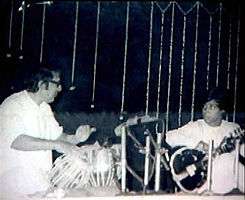Benares gharana

Benares gharānā is one of the six most common styles of playing of the Indian tabla.[1]
History
The Benares tabla gharana was developed a little over 200 years ago by Ram Sahai (1780–1826). Ram Sahai began studying the tabla with his father from the age of five. At the age of nine, he moved to Lucknow to become the disciple of Modhu Khan of the Lucknow gharānā. When Ram Sahai was seventeen years old, Wazir Ali Khan, the new Nawab, asked Modhu Khan if Ram Sahai could perform a recital for him. Modhu Khan agreed, on the condition that Ram Sahai would not be interrupted until he finished playing. It is said that Ram Sahai played for seven consecutive nights, and that after this incredible performance, Ram Sahai was praised by all the members of the community and was showered with gifts. Shortly after this performance, Ram Sahai returned to Benares.


After some time performing in Benares, Ram Sahai felt the need to make a significant change in his tabla playing. For six months, he withdrew into seclusion, and worked to develop what is now known as the Benares baj or style of tabla playing. The philosophy behind this new style of tabla playing is that it would be versatile enough to perform solo, and to accompany any form of music or dance. The tabla would be able to play delicately, as required for khyal, or more aggressively, like pakhawaj, for the accompaniment of dhrupad or kathak dance. Ram Sahai developed a new way of fingering the tabla strokes; especially important is the sound Na, being played with a curved ring finger to allow for maximum resonance of the dahina. He also composed numerous compositions within existing compositional forms (gats, tukras, parans etc.) and created new forms, such as uthan, Benarsi theka, and fard.
Sharda Sahai was the 5th generation of tabla players in the family. Sanju Sahai, also known as Vishnu, represents the 6th generation and is one of the most sought after Tabla players of his generation. Both are the direct descendents of Ram Sahai.
Characteristics
Today, the Benares tabla gharana is well known for its powerful sound, though Benares players are also very capable of playing delicately and sensitively. The gharana is categorized into the Purbi (eastern) baj, which includes the Farukhabad, Lucknow, and Benares gharanas. The Benares style makes use of the more resonant strokes of tabla, such as Na (played on the lao), and Din. Benares players preferentially use the full-hand TeTe strokes, rather than the single finger alternation preferred by the Delhi style, though both stroke types are integrated into the Benares baj repertoire. Benares tabla players are successful in all forms of tabla playing, including tabla solo, instrumental, vocal, and dance accompaniment.
The Tabla solo is highly developed in the Benares gharana, and some artists, such as Anokhelal Mishra (disciple of Bhairow Prasad Mishra of 4th generation), Samta Prasad,[2] and Kishan Maharaj,[3] have become famous as tabla soloists. The direct descendants making up the 6th generation of tabla players are Ramji Mishra (son of Anokhelal Mishra), Mahapurush Misra, Ishwarlal Mishra (alias Lallu), Chhotelal Misra, Radhakanta Nandi, Kashinath Mishra (son of Anokhelal Mishra), Ananda Gopal Bandopadhyay (disciple of Mahadev Prasad Mishra), Shashanka Shekhar Bakshi (disciple of Samta Prasad), Chandra Nath Shastri (disciple of Anokhelal Mishra), Bityut Banerjee, Deepak Sahai, Sanju Sahai and Shiv Sahai. The 7th generation consists of Kumar Bose (disciple of Kishan Maharaj), Aditya Sahai, Krishna Sahai and Shubham Sahai.
Other noted artist include Kanthe Maharaj, uncle and Guru of Kishan Maharaj, and whose disciples were Badri Maharaj, Ashutosh Bhattacharya.[4][5]
The Benares baj makes use of over twenty different compositional types, and has an enormously varied repertoire of each type.
Reputed players from the gharana include Anokhelal Mishra, Samta Prasad, Kishan Maharaj, Ramji Mishra, Mahapurush Misra, Ashutosh Bhattacharya, Sharda Sahai, Shashanka Shekhar Bakshi, Chandra Nath Shastri, Ananda Gopal Bandopadhyay, Kumar Bose and Udai Mazumdar.
See also
References
- ↑ Kumar, Raj (2003). Essays on Indian music (History and culture series). Discovery Publishing House. p. 200. ISBN 81-7141-719-1.
- ↑ "Samta Prasad". kippen.org. Archived from the original on September 7, 2008. Retrieved 2009-05-01.
- ↑ Shovana Narayan (May 6, 2008). "Pt Kishan Maharaj: End of an era". The Tribune.
- ↑ "Biography of Kanthe Maharaj". varanasi.org. Retrieved July 24, 2013.
- ↑ Susheela Misra (1990). Some immortals of Hindustani music. Harman Pub. House. p. 127. ISBN 978-81-85151-14-4.
- Sahai, Sharda and Shepherd, Frances A. 2000 Play Tabla, A Manual for Tabla Playing. Sittingbourne: Asian Education Press.
- Shepherd, Frances A. 1976 Tabla and the Benares Gharana. Ann Arbor: University Microfilms International. (Ph.D. Dissertation).
External links
- SBS Radio, Australia - Broadcast: Interview with Pundit Chandranath Shastri of Banaras Tabla Gharana about the specialty of Banaras Gharana
- Benares Tabla Gharana
- Benares Tabla Gharana